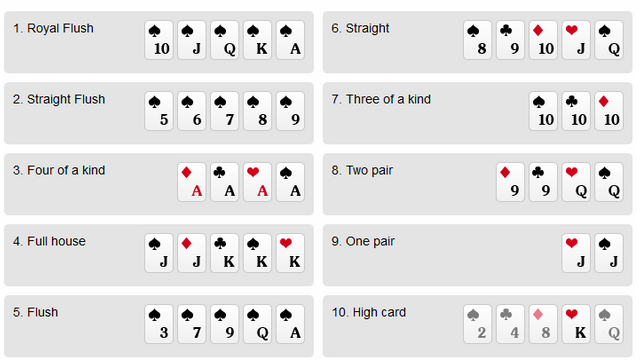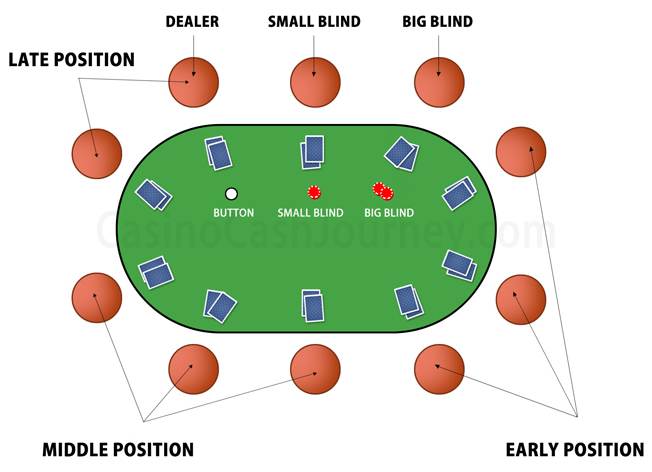(1) Texas Hold'em Basic Knowledge
Your poker career should begin by making sure you understand the rules.

Texas Hold'em is played using a standard 52 card deck, and between two to ten players. Big tournaments may include many hundreds of players but during any one hand, the player is only competing against others on his table.
Poker Hand Rankings:

Poker Table Positions:

Early position
The player to the left of the big blind is called 'under the gun', as they’re the first to act (no pressure). Depending on the overall size of the table, this and the next seat are known as ‘early position’ and are the hardest to play, as you have no idea what anyone else is going to do. Therefore, in theory, you should only play the very best hands (pair of two 10s or higher, ace-king or ace-queen).
Don't worry about having a bad seat when you sit down, because the dealer button moves each hand.
Mid-position
The next couple of seats are relatively good spots, as you get to see what the first players are up to. You can add a few more pairs and suited connectors to your repertoire here. In the next seat, called hijack (and a sort of halfway house between middle and late position), you should raise with any pair.
Late position
Late position (the cutoff and button) are the best seats in poker, as you’ve had the chance to see what everyone else is doing. If everyone else has folded, you can have an average hand and still ‘steal the blinds’ (win the pot straightaway). This means you can raise with a lot more cards, like any ace where the other card is of the same suit, and all suited connectors.
The blinds
Finally, play comes back round to the blinds . Here, if most people have called, then you should call with a range of hands you’d play in late position. If there’s been a raise, stick with early position starting hands. If no-one’s raised yet, blinds also have the option to check (pass this turn to bet). But in cash games, it’s better to raise with good hands or fold.
Fold, call or raise?
In poker, you have three options: fold (throw away your cards), call (put in the same as the previous bet – if no-one’s raised, the same as the big blind) or raise. When you raise, you can bet any amount, as long as it's at least twice the previous bet.
Usually, if your cards are worth playing, you’d raise to three or four times the previous bet. Why raise? Well, firstly, to build bigger pot – and win more money. It’s also to get players with weak hands to fold (fewer opponents mathematically improves your odds of winning, whatever your hand).
If someone’s raised in front of you, it’s wiser to call instead of raise – unless you have a really strong hand like a top pair (jacks or higher), or ace-king, ace-queen (in which case raise to three times the previous bet). If they raise again and you have two kings or two aces, go all-in. If not then call.
If no-one’s raised, it’s really a case of raise or fold. As a cash game player, this will give you more options after the flop and win you more hands.
After the flop, things get a bit trickier, but the same principles apply – you can get away with things ‘on the button’ that you shouldn’t think of trying ‘under the gun’.
There are basic knowledge of poker what you need to know.
Good Luck !
I like Hold'em. Great job at showing us an overall description of it; I upvoted you. Looking forward for your next posts.
now I started follow u.. Could u please support me as I new here